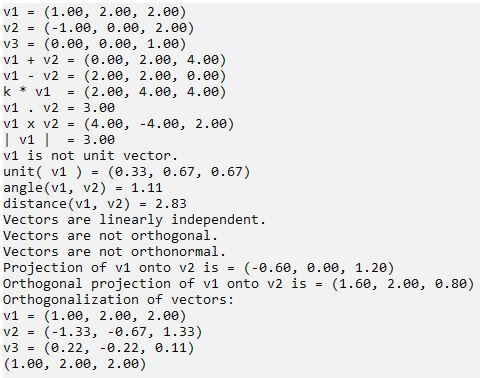Complete the C program that makes many operations on 3D vector spaces by considering the following details. The program contains a structure which represents a
Complete the C program that makes many operations on 3D vector spaces by considering the following details.
The program contains a structure which represents a 3D vector, the main function and many functions prototypes. You must write the functions whose prototypes have been given.
A sample output is given below for the given main function:
THE DEFINITION OF FUNCTIONS |
| void print_vector(const Vector v): It prints the vector as shown in output |
| Vector sum(const Vector v1, const Vector v2): It returns the sum of two vectors. |
| Vector diff(const Vector v1, const Vector v2): It returns the difference of two vectors. |
| double dot_product(const Vector v1, const Vector v2): It returns the dot product of two vectors. |
| Vector cross_product(const Vector v1, const Vector v2): It returns the cross product of two vectors. |
| double norm(const Vector v): It returns the norm (length) of a vector. |
| int is_unitvector(const Vector v): It check whether a vector is unit vector or not. |
| Vector unit(const Vector v): It returns the unit vector of a vector. |
| Vector multiplyby_scalar(const Vector v1, const double c): It returns the vector that is the scalar multiplication of a vector by a constant. |
| double angle(const Vector v1, const Vector v2): It returns the angle between two vectors. |
| double distance(const Vector v1, const Vector v2): It returns the distance between two vectors. (|v1-v2|) |
| int are_linearly_independent(const Vector v1, const Vector v2, const Vector v3): It check whether three vectors are linearly independent or not. |
| int are_orthogonal(const Vector v1, const Vector v2, const Vector v3): It check whether three vectors are orthogonal or not. |
| int are_orthonormal(const Vector v1, const Vector v2, const Vector v3): It check whether three vectors are orthonormal or not. |
| Vector projection(const Vector v1, const Vector v2): It returns the projection vector of v1 onto the vector v2. |
| Vector orthogonal_projection(const Vector v1, const Vector v2): It returns the orthogonal projection vector of v1 onto the vector v2. |
| int convert_2_orthogonal_basis(Vector *v1, Vector *v2, Vector *v3): It converts three linearly independent vectors into an orthogonal basis by using the Gram Schmidt Process. If vectors are not linearly independent, the function return 0, otherwise it returns 1. |
| char* vector2str(const Vector v): It converts a vector into a string (such as “(2.00, 1.00, 0.00)”) and it returns the string. Clue: You can use sprint() function. |
v1 = (1.00, 2.00, 2.00) (-1.00, 0.00, 2.00) v3 = (0.00, 0.00, 1.00) v2 v1 + V2 = v2 = = - v1 k * v1 v1 v2 = 3.00 v1 x v2 - (4.00, -4.00, 2.00) = 3.00 I v1 | v1 is not unit vector. I (0.00, 2.00, 4.00) (2.00, 2.00, 0.00) (2.00, 4.00, 4.00) = unit ( v1 ) = angle (v1, v2) (0.33, 0.67, 0.67) 1.11 = distance (v1, v2) = 2.83 Vectors are linearly independent. Vectors are not orthogonal. Vectors are not orthonormal. Projection of v1 onto v2 is = (-0.60, 0.00, 1.20) Orthogonal projection of v1 onto v2 is = (1.60, 2.00, 0.80) Orthogonalization of vectors: v1 = (1.00, 2.00, 2.00) v2 = (-1.33, -0.67, 1.33) v3 = (0.22, -0.22, 0.11) (1.00, 2.00, 2.00)
Step by Step Solution
3.48 Rating (174 Votes )
There are 3 Steps involved in it
Step: 1
Explanation The functions whose prototypes have been Length of stdvector In stdvector also the size function returns the length ie number of elements in the vector Lets see an example of stdvector inc...
See step-by-step solutions with expert insights and AI powered tools for academic success
Step: 2

Step: 3

Ace Your Homework with AI
Get the answers you need in no time with our AI-driven, step-by-step assistance
Get Started



